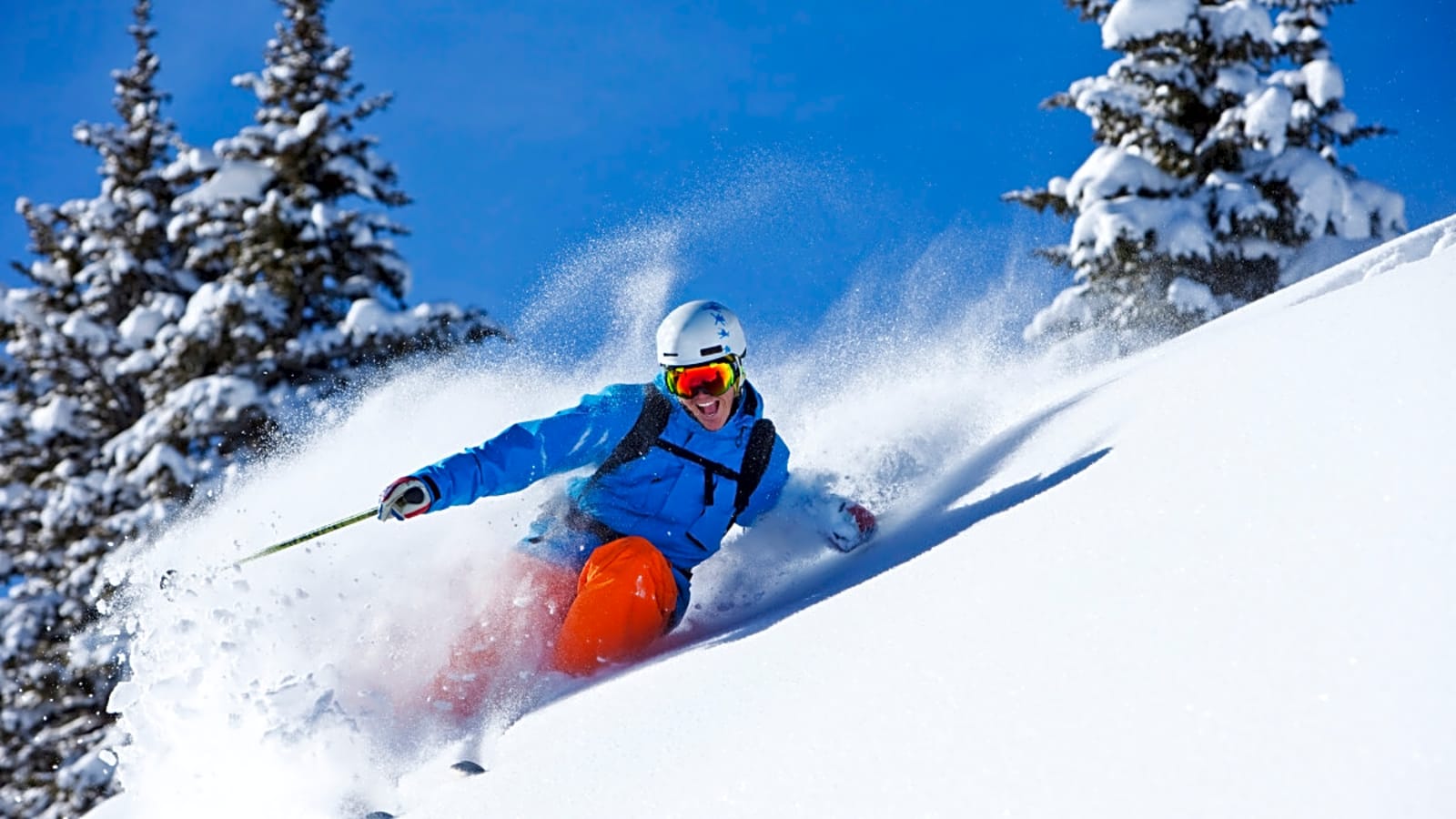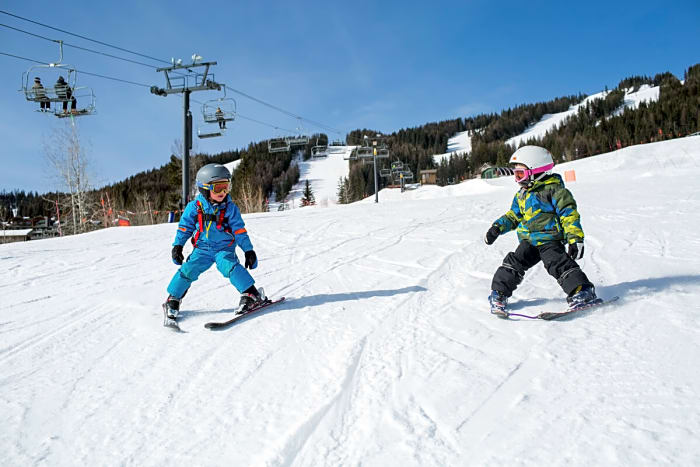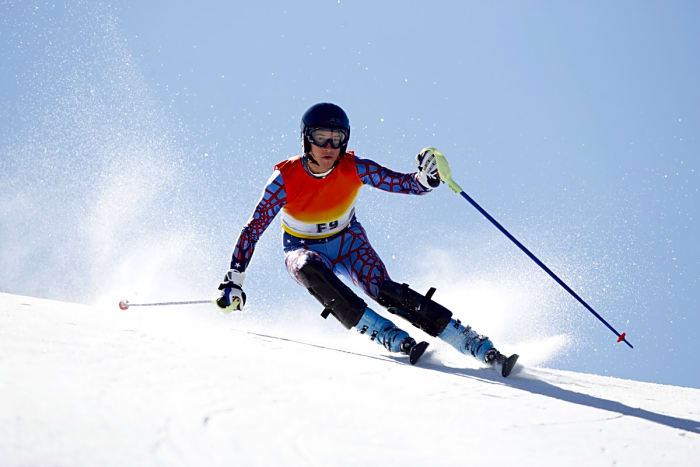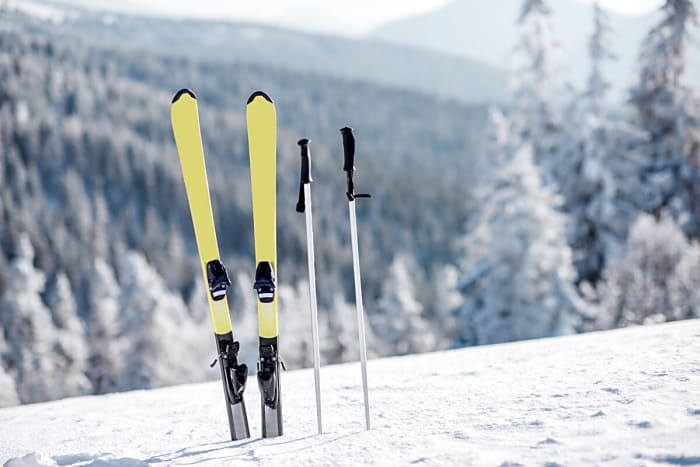
Ski turns are hard, so why bother? From a practical standpoint, the tight and narrow half circles that bring skiers down the mountain offer control, whether that’s setting the pace or choosing where exactly you want to go. But ski turns and skiing are about more than practicality—they’re about the feeling. With speed, gravity, and snow as the key ingredients, good times are guaranteed as long as you can link a turn or two.
These are the basics.
Want to keep up with the best stories and photos in skiing? Subscribe to the new Powder To The People newsletter for weekly updates.
The Fundamental Turn Types
There are a lot of names for ski turns. These exhaustive terms aren't invalid—skiers just have loads of different words for the things they like—but they can be overwhelming. So, instead of throwing the figurative ski turn book at you (one could probably think of hundreds of names for ski turns if they really tried), we’ve compiled a selection of fundamentals.

Wedge Turn
During a wedge turn, a skier slides their skis into a triangular shape, allowing them to control their speed with the insides of their ski edges. This helps beginner skiers get down gentle slopes without accumulating too much speed or tangling with the more complicated details of a parallel turn. You could think of the wedge as an equivalent to training wheels on a bike—it'll help you get comfortable on skis before graduating to a higher level.
While you may hear a wedge called a "pizza" or "snow plow," Jim Shaw, a Professional Ski Instructors of America (PSIA) certified instructor with over 40 years of experience, explained that the term “wedge” is more commonly used in the modern ski instruction context.
“The reason the snow plow was changed to a wedge is the snow plow sort of conjures up images of plowing snow to put the brakes on,” said Shaw. “The goal in the wedge is to try and move people more towards controlling speed through direction change, and less through just putting on the brakes.”
Beyond the beginner stage, wedge turns aren’t commonly used by skiers. Instead, more advanced skiers usually control their speed by executing a hockey stop, skidding mid-turn, or changing the shape of their turn.
For those unfamiliar, a hockey stop involves turning your skis so they face across the slope while leaning into their uphill edges to create friction. This motion looks almost identical to the technique hockey players use to stop.
Wedge Christie
The Wedge Christie borrows elements from the wedge and parallel turn. During this turn, the skis begin in a parallel position before transitioning into a wedge as they start pointing downhill. According to the PSIA, most skiers will “pass through a phase in their skiing development where their movements create a spontaneous Wedge Christie-like turn.” This style of turn can serve as a bridge between wedge and parallel skiing.

Parallel Turn
The parallel turn is a broad category where much of the skiing you’ll see on the mountain takes place. Put simply, it refers to turns made without executing a wedge.
Here, the skis remain parallel throughout the duration of the turn. There’s plenty of wiggle room within this category—parallel turns can look a number of different ways—but during its execution, skiers generally oscillate between two poles: skidding and carving.
Skidding: This is a common technique on the mountain that involves brushing your skis against the snow through the turn with a gentler touch, scrubbing speed in the process. The control afforded by a skid turn makes it a useful tool in more challenging terrain.
Carving: Have you ever seen perfect edge marks in the snow that resemble train tracks? Those were left by a skier executing a carved parallel turn. These turns are one of the more advanced techniques skiers can learn, and they involve rolling the skis on edge and holding them in that position through the entirety of the turn. Beyond being the mark of a skilled skier, carving is an absolute blast and one of the best ways to enjoy a wide-open groomed run.
Neither skidding nor carving is absolute. Any given parallel turn can have elements of both moves, and seasoned skiers know when to alter how much they let their skis carve or skid.
Carving can result in acceleration, while skidding serves as a form of active braking. Depending on the snow or the steepness of the run, both techniques are useful and carving, despite being considered the highest caliber form of skiing, won’t work in every situation.
For instance, trying to keep your skis “on edge” through the duration of an icy mogul field would, for the majority of skiers, be a death wish. Experimentation, rather than devotion to accomplishing one style of parallel turn, is worthwhile when progressing your skills. Shaw also noted that most turns will always have a bit of skid to them.
“It depends on the power of your microscope. If you look closely enough, well probably almost every turn will go sideways a little bit,” he said. “So it's a spectrum of things, if you will.”
Hop Turns
Hop turns are an advanced technique that is most commonly used in steep terrain where skiers don’t have much room to move around. First, while their skis are still facing across the hill, the skier crouches down and prepares to hop into the air. Then, as they’re jumping, they execute a small twist of the hips so that when they land, their skis are facing the other direction. It’s almost like doing several 180s in a row, but not quite.
“Sometimes I get into bumps and steeps where you find that the first half of the turn might be floating in the air,” said Shaw. “You know, just to bring the skis into the fall line a little quicker.”
In effect, with hop turns, the skier takes considerably less room on the slope than they would have with a different, larger turn shape. Additionally, hop turns make controlling speed easier because, after landing, you’ll almost be in a “hockey stop” position. Tight chutes and tight trees are great places to use a hop turn, but you can learn this move on a gentle, groomed run before taking it to more challenging terrain.

Turn Radius and Sidecut, Explained
Sidecut describes the amount that a ski pinches inwards below the binding. For example, a ski that has wide tips, wide tails, and a narrow area in the middle would have a deep sidecut, and a ski that looks more like an unshaped plank of wood would have shallow sidecut.
This element of ski design has a direct impact on turn radius. The deeper the sidecut a ski has, the more it’ll want to drop the user into tight, snappy turns. In contrast, big powder skis often have the least amount of sidecut, facilitating wide, high-speed turns through deep snow.
To add a more specific example: a ski with deep sidecut might have turn radius of 10 meters, while that wide and straight option could top out at 20 meters or more.
However, there are skis that experiment with these defined categories, like the LINE Sakana, which is relatively wide under the ski boot but has a significant amount of sidecut. In a more strange case, the ARG II UL has a reverse sidecut, meaning the middle of its ski is the widest point. Skis with the latter design work best when the snow is bottomless. Given their rarity, we’ll leave it at that.
How Do You Improve at Ski Turns?
Practice, practice, practice. There’s no supplement for hours spent on the snow working to improve your technique. Visual cues, like YouTube tutorials, can help expedite this process.
Heading to the mountain and booking a lesson with an instructor like Shaw is worthwhile, too. They can review your technique and provide moment-to-moment feedback on what you need to do to progress. The value of instruction can’t be understated—it’s difficult to know how well you’re skiing without third-party observation from an expert. Barring a human-to-human interaction, you could try Carv, a well-reviewed digital ski coach that uses sensors and a phone application to analyze your on-snow game.
More must-reads:
- CBB weekend winners, losers: Monster matchups take center stage
- Mavericks icon Dirk Nowitzki perfectly explains why firing Nico Harrison was necessary
- The 'Men's Final Four hosts since 2000' quiz
Breaking News
Trending News
Customize Your Newsletter
 +
+
Get the latest news and rumors, customized to your favorite sports and teams. Emailed daily. Always free!








